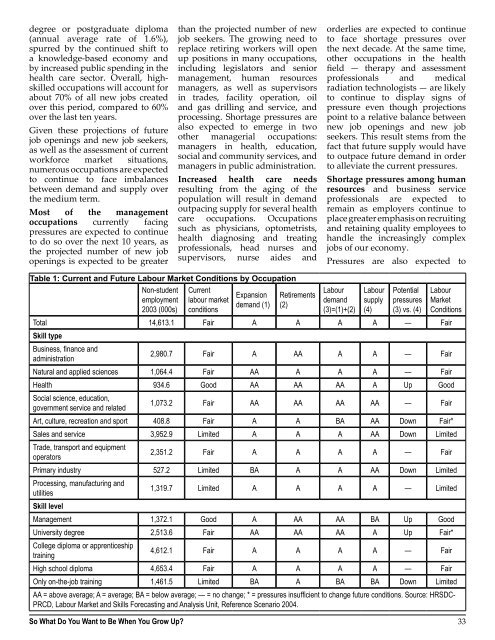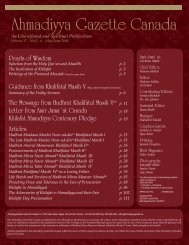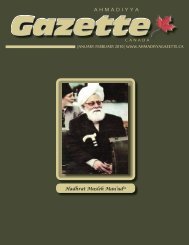When you graduate from auniversity, even if times are toughand there aren’t many job openings,you have made connections. Youhave made an impression on peoplein your chosen field. Your biggestproblem will be deciding whichjob offer to take. You have scoredyour first job. Since you targetedthis career through the careerplanning process, you are in a jobyou can do well. Opportunitiesand promotions come your waywith the help of Allāh. You enjoywhat you do. The rewards startflowing in. You are able to supportyour family, give charity, buy thatdream car, and the dream house.Your dreams have become realitywith the grace of Allāh.Sound too good to be true? Notreally. If you consider that mostof your peer groups will not haveaccess to any career planning, youcan have a competitive advantage.Most students do not get theopportunity to figure out whatthey want to do. In most cases,it is because no one shows themhow. That is where your prayers,parents, community leaders andguidance counsellor can help.Now that you are convinced thata little planning in the high schooland higher education can go a longway in placing you in overdrivemode for your career. Besidesexploring your own inner self andgetting career guidance you mayalso want to see how the Canadianjob markets are doing so thatyou can match your abilities andinterest with high demand fieldsof the future (when you completeyour education).Part IIWorkforce Projectionsin <strong>Canada</strong>In <strong>Canada</strong> the total employmentis expected to grow at an annualaverage rate of 1.1% to 2015.The Canadian economy shouldstill create about 1.9 million newjobs over the next 10 years. Overthe next 10 years, employmentgrowth in the service sector (1.2%)is expected to outpace that in thegoods-producing sector (0.8%),continuing a long running trend.This is largely the result of strongerproductivity growth in the goodsproducingsector, as manufacturersare expected to continue improvingefficiency in order to remaincompetitive in the face of thelofty Canadian dollar and intenseinternational competition.Among services, employmentgrowth should be particularlystrong in the health, computersystem design and professionalservices sectors. This vigorousgrowth will be mainly the result ofincreased public spending in healthcare made possible by the improvedfinancial position of governments,to the continued shift towards aknowledge-based economy and toincreased investment in researchand development.Within the goods-producingsector, high energy prices willcontinue to spur investmentspending and output in theoil and gas sector, while thecomputer and electronic products,other transportation equipment(especially aerospace), andfabricated metals manufacturingindustries will benefit from strongglobal demand and high corporateprofits. In contrast, the auto andparts sector is expected to strugglein the face of faltering auto demandin North America, as are the forestryFigure 3industry and the wood productsmanufacturing industry, whichwill be affected by the weakeningof residential constructionOver the next 10 years period, it isexpected that about 1.7 million newnon-student jobs will be createdas a result of increasing economicactivity (expansion demand),while close to 3.8 million existingpositions will be freed up byretirements. In other words, about70% of all job openings during thatperiod will be associated with theneed to replace retired workers, upfrom an average of about 51% overthe last ten years. Retirements willaccount for an even higher share oftotal job openings over the longerterm. Key occupations that will facestrong retirement pressures includeelementary/secondary schoolteachers and registered nurses,as well as managers in publicadministration, health, education,social and community services.Over this period, about twothirds (65.9%) of job openingsresulting from both expansiondemand and retirements areexpected to be in occupationsusually requiring postsecondaryeducation (university degree) orin management (again requiringuniversity degree and experience),up slightly from 63% over the lastten years.The highest rate of expansiondemand is expected to be inoccupations that require a university32 So What Do You Want to Be When You Grow Up?
degree or postgraduate diploma(annual average rate of 1.6%),spurred by the continued shift toa knowledge-based economy andby increased public spending in thehealth care sector. Overall, highskilledoccupations will account forabout 70% of all new jobs createdover this period, compared to 60%over the last ten years.Given these projections of futurejob openings and new job seekers,as well as the assessment of currentworkforce market situations,numerous occupations are expectedto continue to face imbalancesbetween demand and supply overthe medium term.Most of the managementoccupations currently facingpressures are expected to continueto do so over the next 10 years, asthe projected number of new jobopenings is expected to be greaterthan the projected number of newjob seekers. The growing need toreplace retiring workers will openup positions in many occupations,including legislators and seniormanagement, human resourcesmanagers, as well as supervisorsin trades, facility operation, oiland gas drilling and service, andprocessing. Shortage pressures arealso expected to emerge in twoother managerial occupations:managers in health, education,social and community services, andmanagers in public administration.Increased health care needsresulting from the aging of thepopulation will result in demandoutpacing supply for several healthcare occupations. Occupationssuch as physicians, optometrists,health diagnosing and treatingprofessionals, head nurses andsupervisors, nurse aides andorderlies are expected to continueto face shortage pressures overthe next decade. At the same time,other occupations in the healthfield — therapy and assessmentprofessionals and medicalradiation technologists — are likelyto continue to display signs ofpressure even though projectionspoint to a relative balance betweennew job openings and new jobseekers. This result stems from thefact that future supply would haveto outpace future demand in orderto alleviate the current pressures.Shortage pressures among humanresources and business serviceprofessionals are expected toremain as employers continue toplace greater emphasis on recruitingand retaining quality employees tohandle the increasingly complexjobs of our economy.Pressures are also expected toTable 1: Current and Future Labour Market Conditions by OccupationNon-studentemployment2003 (000s)Currentlabour marketconditionsExpansiondemand (1)Retirements(2)Labourdemand(3)=(1)+(2)Laboursupply(4)Potentialpressures(3) vs. (4)LabourMarketConditionsTotal 14,613.1 Fair A A A A — FairSkill typeBusiness, finance andadministration2,980.7 Fair A AA A A — FairNatural and applied sciences 1,064.4 Fair AA A A A — FairHealth 934.6 Good AA AA AA A Up GoodSocial science, education,government service and related1,073.2 Fair AA AA AA AA — FairArt, culture, recreation and sport 408.8 Fair A A BA AA Down Fair*Sales and service 3,952.9 Limited A A A AA Down LimitedTrade, transport and equipmentoperators2,351.2 Fair A A A A — FairPrimary industry 527.2 Limited BA A A AA Down LimitedProcessing, manufacturing andutilities1,319.7 Limited A A A A — LimitedSkill levelManagement 1,372.1 Good A AA AA BA Up GoodUniversity degree 2,513.6 Fair AA AA AA A Up Fair*College diploma or apprenticeshiptraining4,612.1 Fair A A A A — FairHigh school diploma 4,653.4 Fair A A A A — FairOnly on-the-job training 1,461.5 Limited BA A BA BA Down LimitedAA = above average; A = average; BA = below average; — = no change; * = pressures insufficient to change future conditions. Source: HRSDC-PRCD, Labour Market and Skills Forecasting and Analysis Unit, Reference Scenario 2004.So What Do You Want to Be When You Grow Up?33
















